Continue reading for our analysis...

This video starts with two men out on a fishing boat in the open ocean waters. The two friends are from Sammy Hitzke Fishing, and they’re very excited to have just set out swordfish bait.
It’s a clear, beautiful day, and both men are ecstatic as the fishing rod bends down into the deep blue waters. This isn’t any old candid video. This is an intentional series by these two fishermen with a professional video introduction!
They have plenty of fans — and they know just how to keep their audience entertained.
The next scene cuts to one of the fishermen securing his fighting belt to take manual control of the fishing pole. He leans back and holds the pole steady while it reels.
“This thing hasn’t even stopped. It’s like a freight train,” says the fisherman holding the pole. He knows that whatever he’s caught is big and has a big bite. He could feel the tension of the pole as the underwater sea monster took hold of the swordfish bait.
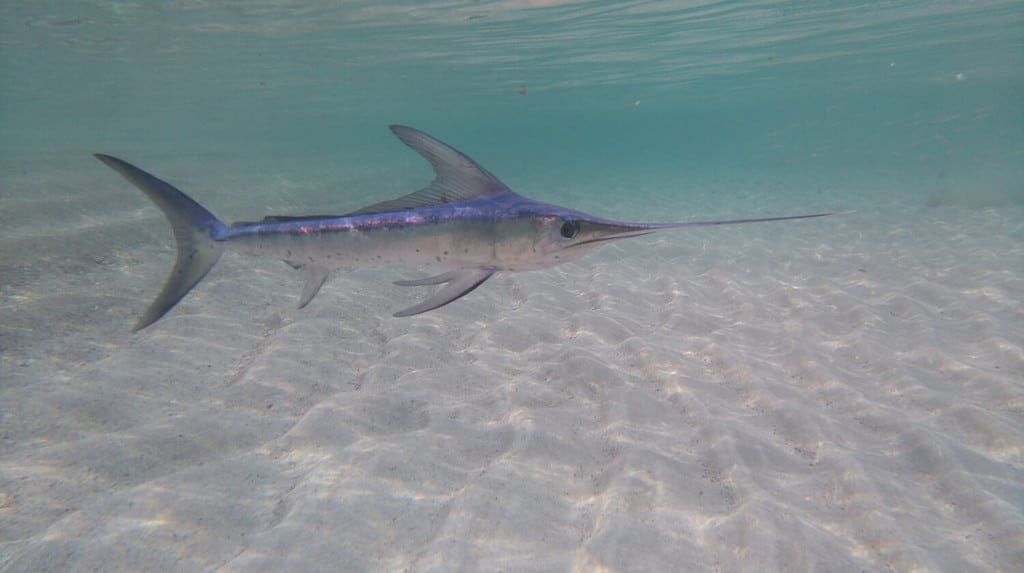
The fishermen in the video below used swordfish bait to attract big catches.
©SVITO-Time/Shutterstock.com
As the video goes on, the men ponder what type of underwater creature they may have captured. The fisherman with the fighting belt and the pole looks back and says, “Very aggressive, whatever it is.”
Several minutes go by, and the man in the hot seat continues wrestling with his catch. His friend cracks open a beer and says that if the catch is what they think it is, then his friend is living out his dream.
The video continues as the men chat about what they could have possibly caught. They’re looking forward to the moment when they can catch a glimpse of it.
Several hours later, they’re able to pull up their catch. It appears to be a shark. As they bring it closer to the boat, they’re able to identify it as a thresher shark.
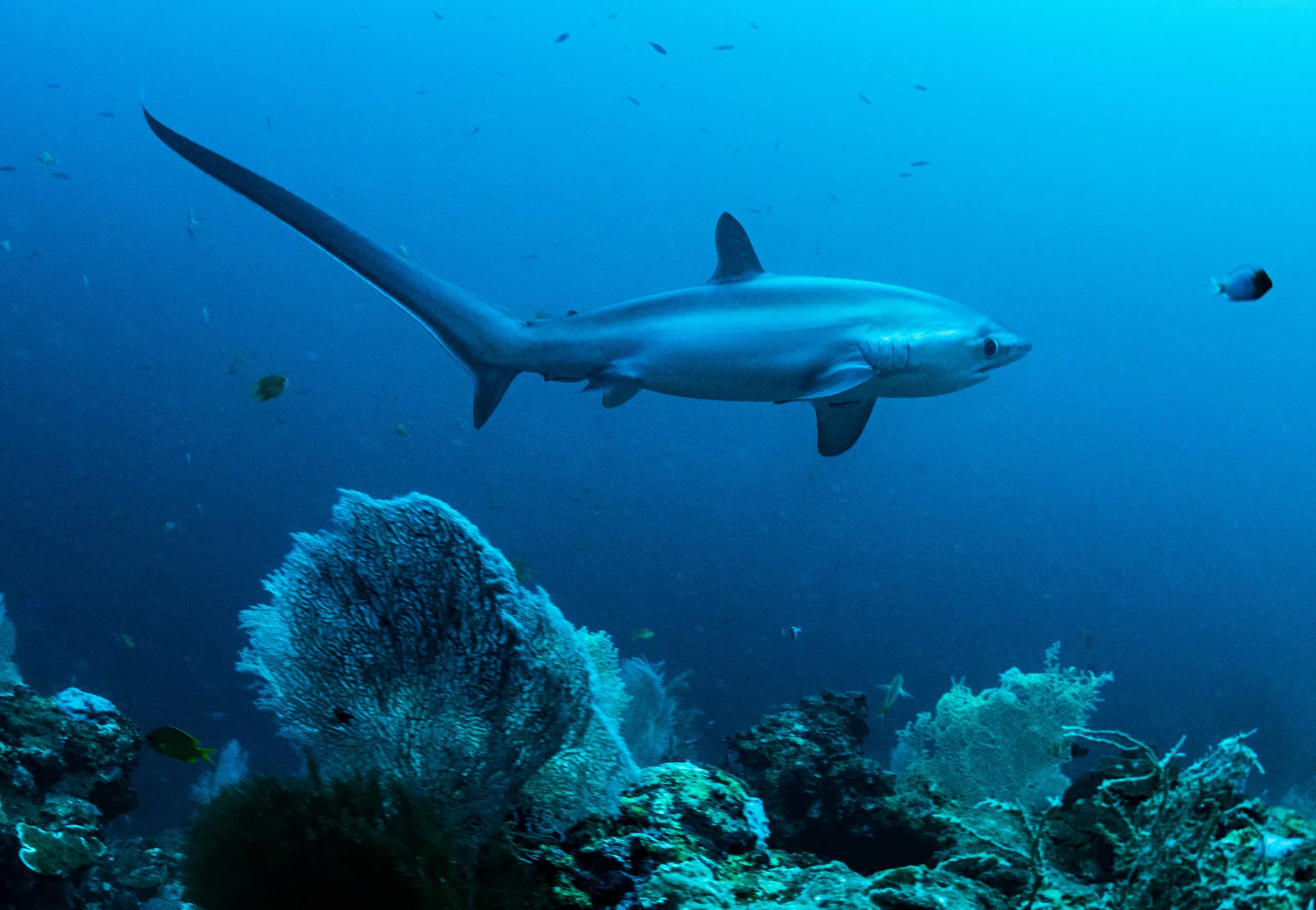
The thresher shark can reach 400 pounds but is vulnerable to bigger sharks such as the great white and whale shark.
©Shane Gross/Shutterstock.com
But something is off with their catch — the head and tail are intact, but its body is missing, with only its skeleton keeping it together.
Although an epic moment, this is not the catch they were hoping for. They both express their disappointment after spending hours wrestling with the thresher shark.
Despite feeling devastated, the fisherman goes on to explain and highlight different parts of the thresher shark. He comments that something monstrous must have taken a big bite out of his catch deep beneath the sea.
Is This Normal Behavior?
You may be wondering: Is it normal for a fisherman who has hooked a thresher shark to wind up with a half-eaten carcass? While we don’t have statistics on this kind of occurrence happening, it’s safe to say that scenario could definitely have played out in the past and can happen again. But why? Thresher sharks can get up to 400 pounds and put up a terrible struggle to get free once hooked by a fisherman. As this video proves, it can take hours to reel in a shark of that size and strength.
Because the shark is hooked, it doesn’t have the ability to escape predators who may approach it. Apex predators of the thresher shark include killer whales and larger sharks like great white sharks, tiger sharks, and whale sharks. Given the long amount of time that this particular thresher shark was on the line as the fisherman struggled to reel it in, the chances of a larger shark spying it and chomping down were probably good.
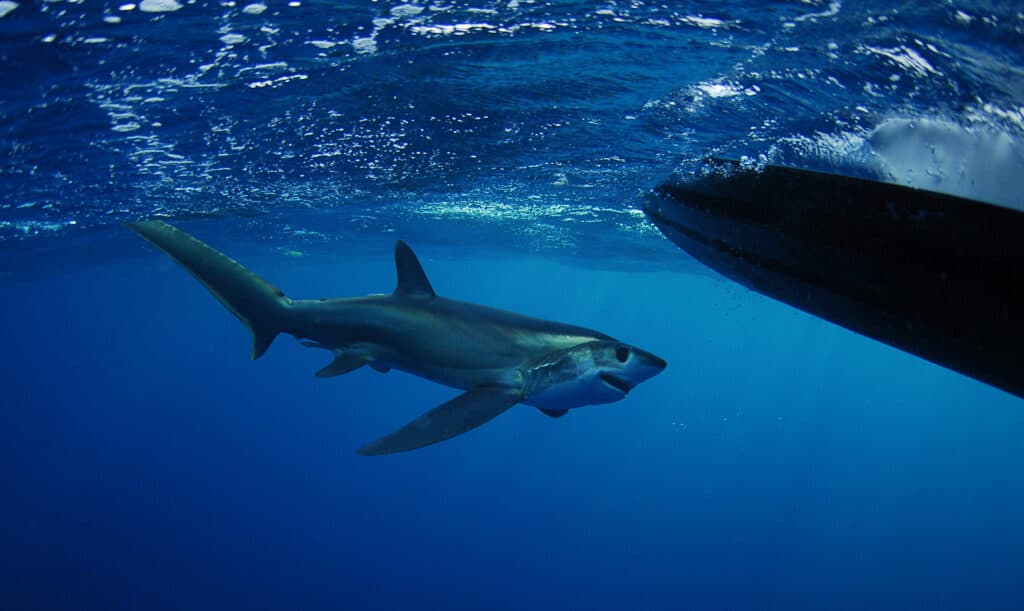
The bigeye thresher shark has extremely large eyes, adapted to hunt in low-light conditions.
©FtLaud/Shutterstock.com
Where Do Thresher Sharks Live?
Thresher sharks live in temperate and tropical waters around the world. They are usually found near continental shelves, often near ocean currents and upwelling areas. Thresher sharks prefer to stay close to the surface of the water, but they can go as deep as 3,900 feet. Several species inhabit different regions. For example, bigeye threshers are found in the Pacific Ocean from Japan to California, while common threshers frequent both sides of the Atlantic Ocean from Norway down south to Brazil. Some have even been spotted off South Africa’s coast and Hawaii’s waters!
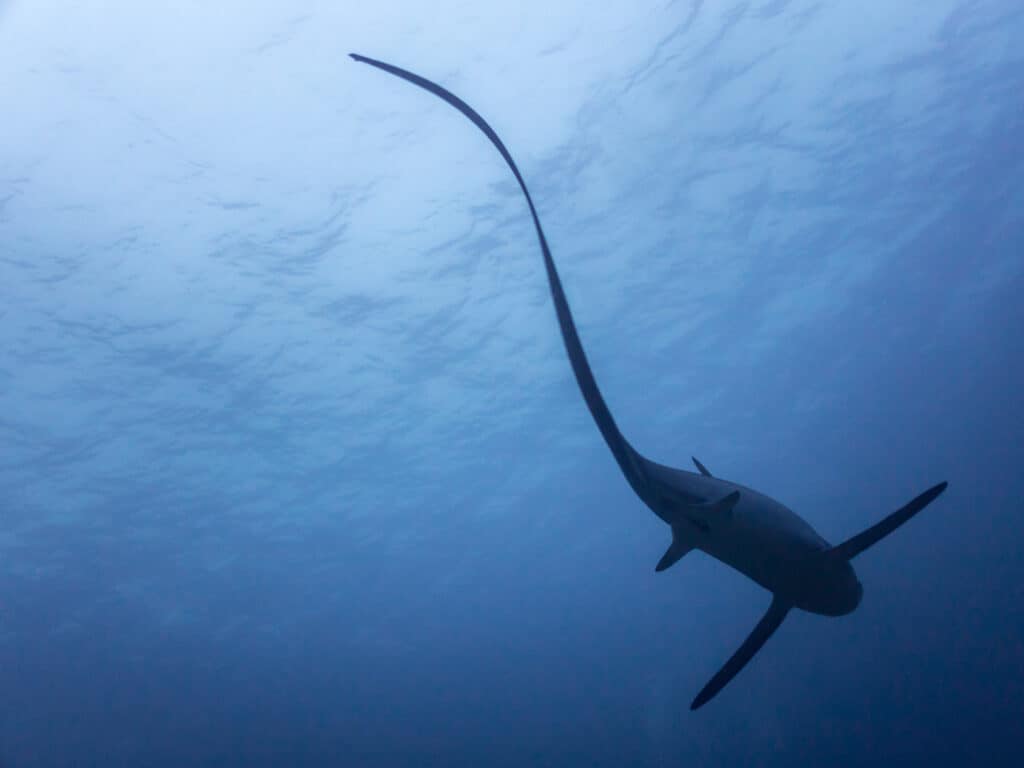
The long tail fin of a thresher shark is used to stun and kill prey.
©HikeAndShoot/Shutterstock.com
Lifespan, Threats, and Conservation
The average lifespan of a thresher shark is believed to be between 20 and 30 years, though some individuals may live for up to 50 years. Thresher sharks are primarily threatened by overfishing and bycatch, as they are often caught unintentionally in long lines and gillnets used for commercial fishing. In addition, their slow reproductive rate makes them particularly vulnerable when populations become depleted.
As of 2020, the International Union for Conservation of Nature (IUCN) has classified all three species of thresher sharks as “vulnerable” on the Red List due to their declining population sizes.
Conservation efforts have been put in place to help protect these species from further decline. Measures include introducing catch limits on certain types of commercial fishing gear that can accidentally capture thresher sharks, reducing habitat loss through protection zones and marine reserves, improving enforcement against illegal fishing activities, educating local communities about sustainable practices when harvesting seafood resources from the ocean, and increasing public awareness about this species’ plight.

Thresher sharks are threatened by overfishing and bycatch, often caught unintentionally in commercial fishing nets.
©bearacreative/Shutterstock.com
Thresher Shark vs. Great White: What’s the Difference?
The most obvious physical difference between a thresher shark and a great white shark is its size. The average length of an adult thresher shark ranges from 4 to 20 feet, while the average length of an adult great white shark is 11 to 16 feet. Thresher sharks can weigh anywhere between 125 lbs and 575 lbs, whereas great whites weigh from 1,151 to 1,700 lbs. Mature females tend to weigh more, averaging from 1,500 to 2,450 lbs. Amazingly, some great white sharks have been recorded weighing as much as 4,000 lbs!
Thresher sharks are also generally lighter in color than great whites, with some having dark blue backs and light gray sides. Furthermore, they have distinctive long tails that can be up to half their body length. Whereas great white sharks do not possess such large tail fins in comparison.
Behaviorally speaking, thresher sharks tend to be more solitary creatures than great whites, who prefer living together in groups or pods. Additionally, when it comes to feeding habits, the two species differ greatly as well: While both species feed on fish and small marine mammals like seals and dolphins, threshers use their specialized tails for “slapping” their prey, stunning them before eating them, while great whites typically rely on powerful bites instead.
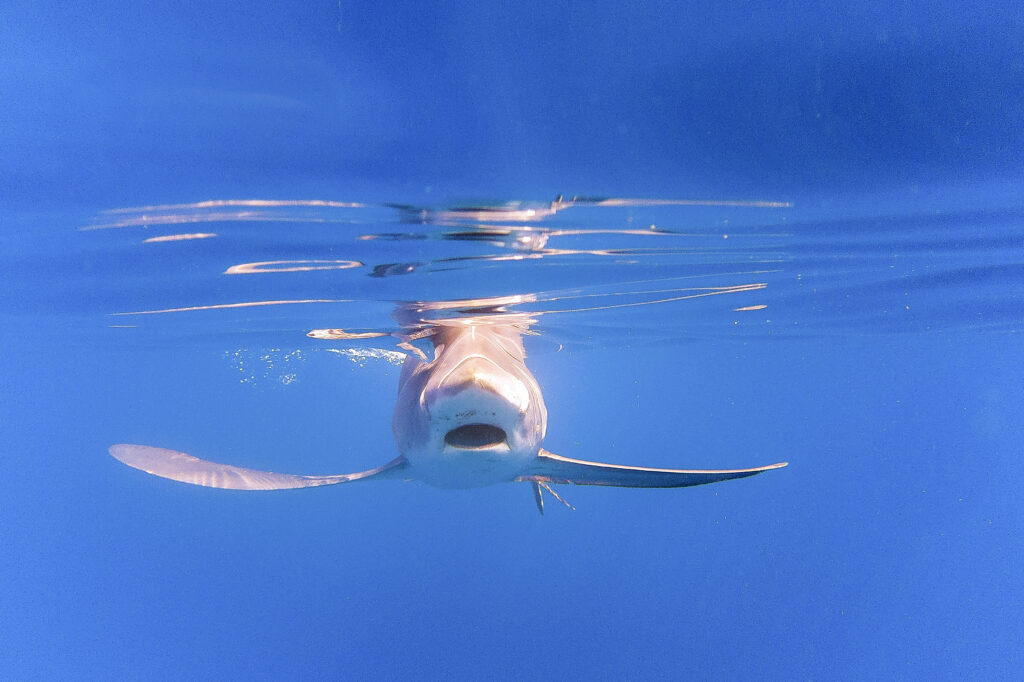
Thresher sharks are smaller in size and lighter in color than great white sharks.
©Xavier Hoenner/Shutterstock.com
Getting back to the video, these relentless fishermen are shown as they continue out on the open waters while night falls. They take turns, and now another fisherman takes the pole. They have another catch, and he battles with it as he reels it up to the surface.
The second catch turns out to be another thresher shark. Except this one is alive and well and uses its very long tail to try and get away.
The man cuts the line and watches as the thresher shark swims quickly away from their boat. They celebrate this surprise encounter with a high five.
The video closes with a short recap of the footage captured and with a quick introduction for the next video in their series.
Thank you for reading! Have some feedback for us? Contact the AZ Animals editorial team.







